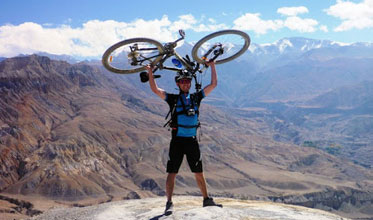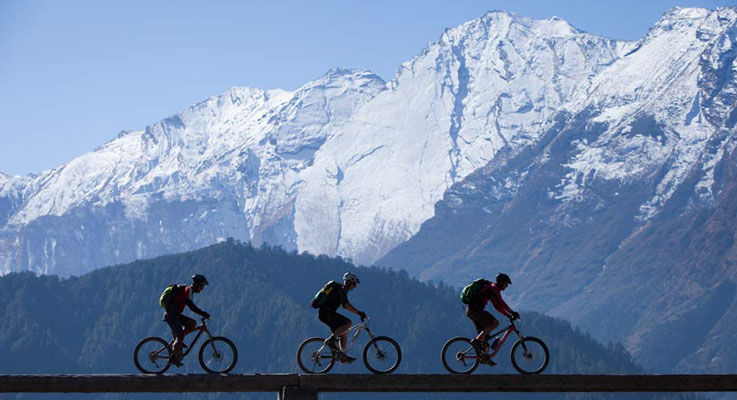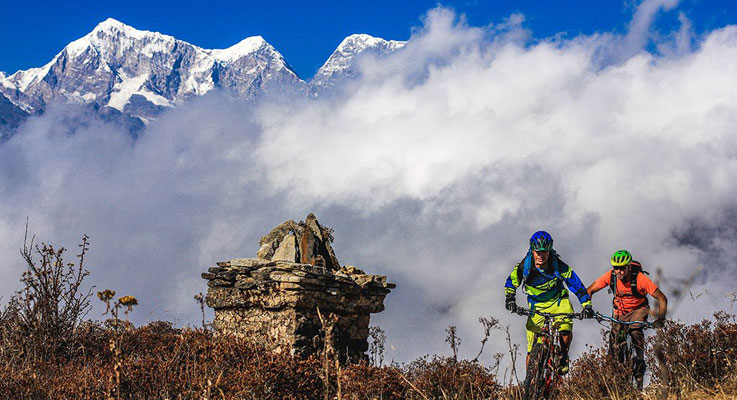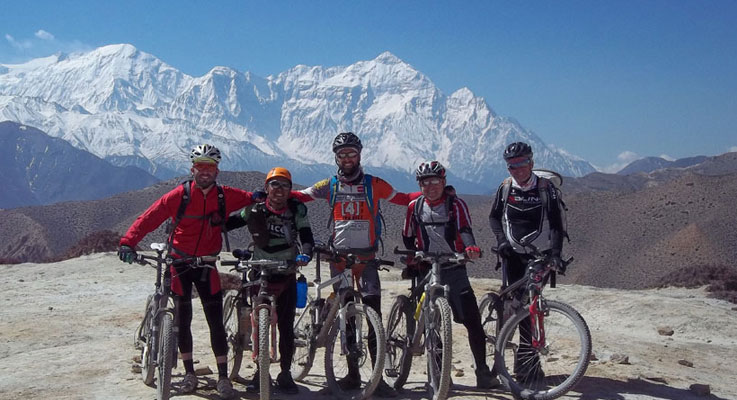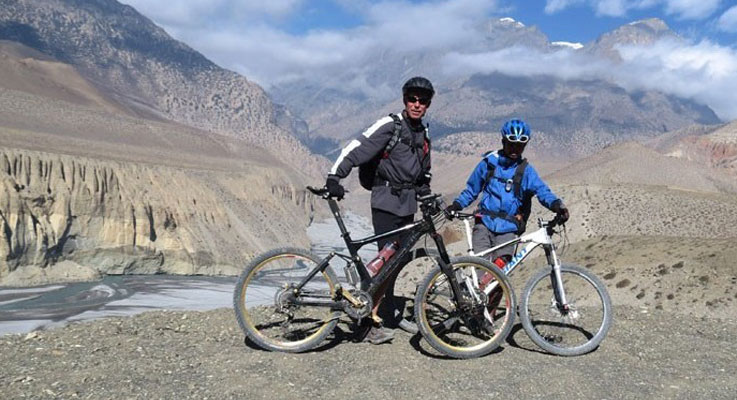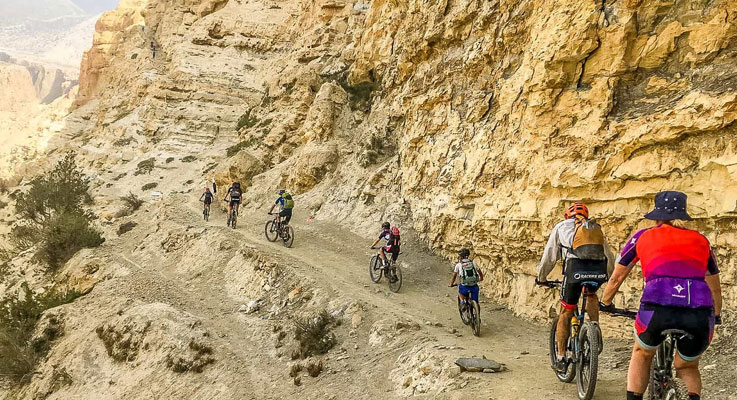-
Day 1
Arrival in Kathmandu. Some sightseeing and trip briefing
Our staff will welcome you at the Tribhuwan International Airport in Kathmandu upon your arrival and transfer you to the hotel on a private vehicle. The evening can be spent exploring Thamel, a tourist hub offering numerous bars, shops and restaurants, followed by the old palace complex at Basantapur Durbar Square, which gives you an instant taste of Nepali life. Later at the hotel, we will brief you on trip details, safety, preparation and essentials for the adventure.
-
Day 2
Drive from Kathmandu to Pokhara. Sightseeing in Pokhara
Early in the morning you will be transferred to the bus station for a 5-hour scenic drive to Pokhara on a tourist bus. Once you reach Pokhara, get awestruck by the lakeside city’s natural beauty. The city lies along the banks of the gorgeous Phewa Lake and sports panoramic views of Machapuchure, Annapurna, Dhaulagiri and Manaslu. Pokhara is much more laid back and less hectic than Kathmandu, which makes it perfect for relaxation and adventure activities alike.
We’ll spend the rest of the day exploring the picturesque Pokhara Valley which offers wonderful natural and cultural points of interest for sightseeing. These include boating on Phewa Lake, exploring Seti River gorges and Gupteshwar Cave, visiting Tibetan Refugee Camps and Barahi temple. The Peace Pagoda is also quite a spectacular hike with an amazing view of the valley below and the Annapurnas at a distance.
-
Day 3
Fly from Pokhara to Jomsom. Bike from Jomsom to Kagbeni
We pack up and head to the airport for our flight to Jomsom. There are several flights from Pokhara to Jomsom in the morning before the high winds in Jomsom pick up late morning. Upon landing, we assemble our bikes and spend some time riding through the cobbled streets of the bustling town. We then head off to Kagbeni, riding the relatively flat section along the river trail. In Kagbeni, you can enjoy a fantastic mix of scenery and native lifestyle. The lively Tibetan culture in the village is sure to give you a warm welcome.
-
Day 4
Bike from Kagbeni to Chele
From Kagbeni we enter the region of Upper Mustang, which until very recently was restricted to travelers. The trail climbs for a short stretch from Kagbeni and then on a dusty path we ride on a short downhill section. There are fantastic views of snowcapped mountains that you can enjoy. Chusang and Tetang villages, around 3,000m in altitude, have rich fields of barley, potatoes and apple orchids. After a short steep climb, we reach the beautiful village of Chele, our destination for the day. Caves believed to be created thousands of years ago can be seen shortly before we reach Chele.
-
Day 5
Bike from Chele to Ghami
Chele La Pass at 3,630m is our first checkpoint, as we pass the Samar valley, and along the way other passes like Taklam La (3,820m) and Yamda La (3,900m). The ride takes us through the tiny settlement of Syangboche village, from where the Ramchung cave and chorten-like stalagmites are just nearby. Indeed, this section makes for one of the most sacred places in Mustang. From Syangboche we descend to the picturesque valley of Geling, where you can see mostly mud houses. Crossing Nyi La Pass (4,027m) today will be demanding but well rewarding once we reach Ghami.
-
Day 6
Bike from Ghami to Lo Manthan
Today we cross the Ghami River and ride along the Longest Mani Wall to reach the village of Charang with panoramic scenery of Nilgiri, Tilicho, Annapurna I and Bhrikuti peaks. We’ll make a quick visit to the Red Monastery at Charang. The walled city of Lo Manthan, the district capital of Mustang, will be visible as we cross Lo La Pass at 3,930m, popularly called Windy Pass. The sight of the old kingdom will make you feel lost in another era. The mystical and isolated city certainly is a major destination of our trip. More than 600 years old, the walls of Lo Manthan are believed to ward off the evil spirits. We’ll spend the evening strolling in the streets of this surreal town.
-
Day 7
Rest day at Lo Manthan
There couldn’t be a better place than Lo Manthan for a rest day, where we will visit three major monasteries (with ancient paintings and art) and a four-storey palace of an old Mustangi king. We’ll mix in with the locals and observe their lifestyle and how they go about their daily chores. To get around Lo Manthan, we’ll hire a horse to visit nearby villages like Choser and other great attractions like the Jong cave tunneling intricately on the mountainside. The experience you get in this old kingdom – of the culture, nature, architecture, people views and the feeling of being in an ancient rustic town – will make special memories.
-
Day 8
Bike from Lo Manthan to Ghami, via Dhakmar
The day starts with a hearty breakfast, riding back to Ghami through challenging but exciting alternative routes that take us over the Pang La Pass situated 4,132m in altitude. From here a thrilling downhill takes us to Ghar Gompa, a beautiful 1200-year-old monastery, and amazing red landscapes of Dhakmar village. The vegetation at Dhakmar is greener that in other places of Upper Mustang. After an hour’s ride on mostly undulating singletracks, we reach Ghami in the late afternoon.
-
Day 9
Bike from Ghami to Samar
The route to Samar is the same way back to Kagbeni, but since we’re taking a detour, the sceneries are much different and you’ll see more of the Annapurna range on a clear day. We ride through a couple of passes on jeep tracks with little to no traffic. The quaint Buddhist village of Samar is one of the larger ones in Mustang and the people here are engaged mostly in agriculture. We’ll see many horses here as they are used for transportation and for agriculture as well.
-
Day 10
Bike from Samar to Kagbeni
Following the newly built dusty downhill jeeptracks along the Kali Gandaki River, we head to Kagbeni. At this point, we will be exiting Upper Mustang and entering Lower Mustang. On this day, we will descend more than 800m in altitude, cover about 30 kms. Once we reach Kagbeni in the afternoon, we will have enough time to explore the village and interact with the local people, a majority of whom are of Tibetan descent.
-
Day 11
Bike from Kagbeni to Muktinath
After an early morning breakfast, we start riding uphill and gain almost 1,000m in elevation. The region is dry and arid, almost desert-like, with awe-inspiring sceneries of the mountains at the horizon. We will come across trekkers and pilgrims, flocking from as far as India, on their way to Muktinath, one of the most revered Hindu temples in the world. Once at Muktinath, we’ll explore the religious site and see the eternal flame that burns on natural gas source. “Mukti” means liberation and “nath” means a holy temple, so Muktinath is considered to be a temple of soul liberation. Besides Hindu hermits and pilgrims, we’ll see some Tibetan traders as well.
-
Day 12
Bike from Muktinath to Tukuche
From Muktinath we ride along a very enjoyable downhill track descending to the Kaligandaki River valley floor. We’ll make a quick pit stop at Marpha, a village with legendary apple orchids. Make sure to taste some Marpha Brandy and a range of apple products like apple pie and dried apple skin. We call it a day at Tukuche village, an ancient Thakali tribe settlement, and spend some time exploring the region and learning about the culture and history of the village. Tukuche lies right beneath the Tukuche peak and Dhaulagiri, with amazing views of Mt. Nilgiri and icefalls of Dhaulagiri’s east face.
-
Day 13
Bike from Tukuche to Tatopani
We begin riding from Tukuche to Tatopani through some fantastic downhill sections. Tatopani translates to “hot water” and rightly so, the hot springs at Tatopani are quite a treat. This is a fabled place to relax your mind and body, so pamper yourself after a great day of biking in this fantastic region. Located besides the banks of the Kali Gandaki River, the hot dip amidst the surrounding natural beauty in Tatopani will definitely unwind your muscles.
-
Day 14
Bike from Tatopani to Beni, and drive to Pokhara
After a relaxing time at Tatopani, we ride for about 1.5 hours on jeep tracks to reach Beni, a small but vibrant market town. We’ll spend some time exploring the town and then drive back to Pokhara on a 4-hour drive. It’s a bumpy drive and you can enjoy the scenic views you get along the away. Once we reach Pokhara, we can do some boating on the Phewa Lake and have a pleasant time reflecting on our thrilling adventure in Upper Mustang.
-
Day 15
Drive from Pokhara to Kathmandu. Farewell dinner in the evening
Our staff will take you to the bus station for an early morning drive to Kathmandu, and transfer you to the hotel. We’ll have some time for some shopping in late afternoon. In the evening, you’re invited for a farewell dinner at a traditional Nepalese restaurant which hosts cultural performances, and you’re more than welcome to join the merry. We toast a round or two of locally brewed drinks to celebrate our trip achievement and to good health! Holidays should never have an ending date. So extend your trip and opt for adventure activities including trekking, bungy jumping, mountain flight, rafting, hiking, Chitwan jungle adventure and Lumbini heritage trip. These can be arranged before or after the biking adventure.
-
Day 16
Flight departure from Nepal
The trip concludes today. Our staff will drop you off at the Tribhuwan International Airport and wish you bon voyage for onward journey.

